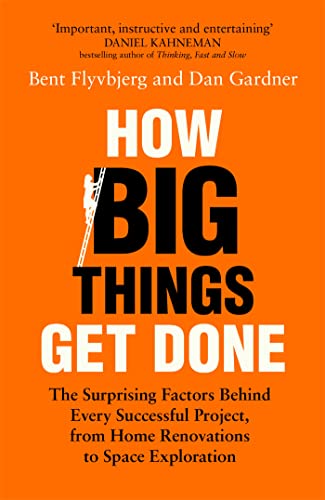Have you ever wondered why so many large infrastructure projects get delayed for years and end up massively over budget?
Oxford University professor Bent Flyvbjerg did, and over the last 30 years, he’s built the world’s largest database of project outcomes, to find out why most projects miss their targets and a small minority don’t.
He recently teamed up with the journalist Dan Gardner on a book called “How Big Things Get Done: The Surprising Factors Behind Every Successful Project, From Home Renovations to Space Exploration.”
In it, Gardner and Flyvbjerg identify several factors that can make or break a project schedule and budget, most of them to do with planning.
The Power of a Plan
When I spoke to Gardner for our Mind Tools Expert Interview, he filled me in on the scope of Flyvbjerg’s groundbreaking research.
Here's an excerpt. (You can stream the audio clip below or read a transcript here.)
Throughout the book, the authors use the example of the renowned architect Frank Gehry, whose big projects consistently meet schedule and budget targets.
They identify several reasons for this, all of which are applicable to much smaller projects – pretty much anything that needs to be planned.
One reason for Gehry’s success is experiential learning – not through failed outcomes, but through an experimental planning phase.
“We’re excellent experiential learners, but we’re really, really bad at trying to figure out a complex problem and coming up with a solution to that complex problem at the first go,” Gardner explains. “You don’t want to be putting yourself in that position. So instead, what you want is a planning process that basically creates experiential learning.”
He told me that Frank Gehry starts by sketching out an idea, gets feedback on it, then sketches another one, gets feedback, and so on. Then he moves to 3D models, then into the digital space, and continues tweaking the idea, making it better each time, until it’s ready to enact.
“His track record is stunning,” Gardner says. “He delivers on budget and on time over and over again, because he engages in precisely this iterative process.”
In this way, the best “planning” is really “doing,” Gardner points out, because it includes experimentation and, in turn, improvement. Pixar Studios works the same way, in its meticulous creation of animated movies.
Think From Right to Left

I can see how this approach would work well for any kind of product development, but it’s less relevant to projects that can’t be test driven, like a one-day conference. Another tip from the book is more widely applicable: “Think from right to left.”
Imagine a project plan on a piece of paper, with conception on the left and delivery on the right. In planning, most people start on the left and move through the various stages until they get to the right.
Gardner and Flyvbjerg noticed that projects work better if you reverse that and start by giving a lot of thought to the end of the process, on the right.
Gardner explains: “We don’t build bridges to have bridges; we don’t build roads to have roads. We build bridges because they deliver some benefit; we build roads because they deliver some benefit.”
This principle applies to projects of all sizes, like that one-day conference. Think about the experience you want the delegates to have. How do you want them to feel when they arrive, during the proceedings, and when they leave? What insight do you want them to take away with them, leading to what actions?
When you know the answers to those questions, you can move back along the project line, making sure that all the pre-event activity contributes to those end goals.
Know Your Reason
I wish I’d known about this approach when I renovated my kitchen a few years ago. Like most people, I started at the left of the project line, focusing on replacing what was already there with new appliances and materials. I never asked myself what problem I wanted to solve, or even why I was doing it in the first place.
If I had, I think I would have ended up with two divergent choices. I might have concluded I was just bored with my kitchen. If I was just tired of the look, my appliances might have been perfectly fine for another few years, and a fresh coat of paint would have done the job. A lot of money and effort could have been spared.
Alternatively, I might have realized that what I really wanted was to have a better space to entertain, and more room to practice my cooking skills. This might have led to a much bigger renovation, including removing walls and spending more money on appliances. Although this would have cost more, it would have added to my quality of life.
Either of these outcomes would have been more suitable for me than the “same but new” kitchen I ended up with.
It’s too late to change that now, but I’m grateful for this insight. Properly considering why we’re embarking on something can have a major impact on how we go about it – and we may conclude that we don’t need to go about it at all.
Listen to the Full Story
You can listen to or read my full 30-minute interview with Dan Gardner if you're a Mind Tools member or if your employer is a Mind Tools for Business licensee.
If you're not already a member, join Mind Tools now to gain unlimited access to 2,400+ resources, including our back catalog of 200+ Expert Interviews. Or find out more about Mind Tools for whole organizations, big or small, by contacting our enterprise team.
Meanwhile, catch more excerpts and insights from my guests by searching our Expert Interview blog topic and by signing up free to the Mind Tools Expert Voices podcast.
The post Plan With Purpose: My Expert Interview With Dan Gardner appeared first on Mind Tools.

0 Commentaires